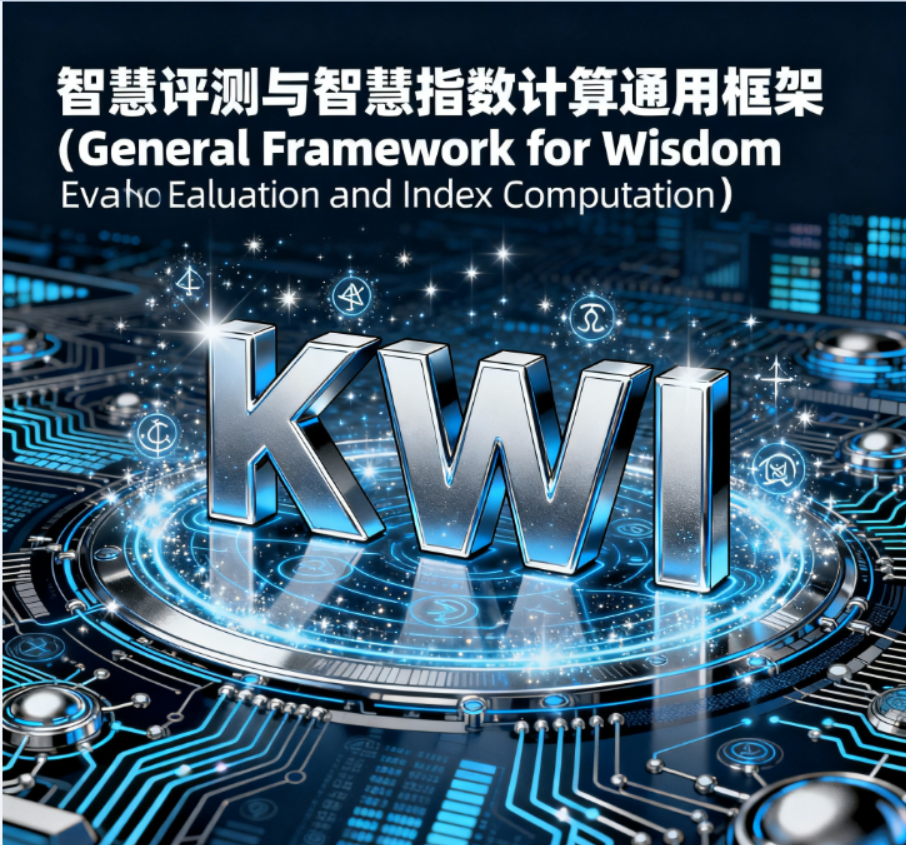智慧评测与智慧指数计算通用框架(General Framework for Wisdom Evaluation and Index Computation)
本文提出《智慧评测与智慧指数计算通用框架》国际标准草案(ISO/IEC KWI 10000:2025),建立了一套完整的智慧评估体系。该框架基于贾子智慧指数(KWI)理论,包含智能、智慧、文明三大主域和20多个子维度,通过数学模型量化智能体的智慧层级。标准定义了智慧共振、认知场等核心概念,提出包含6个等级的智慧分级算法,并给出各类实体的参考KWI值。该框架适用于人工智能系统与人类智慧的评估对比,为

智慧评测与智慧指数计算通用框架(General Framework for Wisdom Evaluation and Index Computation)
本文将以 中英对照、国际标准格式 编制,包含:
-
前言(Foreword)
-
范围(Scope)
-
术语与定义(Terms and Definitions)
-
智慧指数结构(Structure of KWI)
-
评测维度与指标体系(Evaluation Dimensions and Indicators)
-
计算模型(Computational Model)
-
校准方法(Calibration and Benchmarking)
-
实施与验证(Implementation and Validation)
-
附录(Annex A: Example Metrics)
🧭 国际标准草案 / International Standard Draft
ISO/IEC KWI 10000:2025(E)
《智慧评测与智慧指数计算通用框架》
General Framework for Wisdom Evaluation and Index Computation (KWI Standardization Draft)
由 鸽姆智库(GG3M Think Tank) 提出,基于 贾子智慧指数(Kucius Wisdom Index, KWI) 理论体系制定。
前言 Foreword
本国际标准草案旨在为人工智能系统与人类智慧体的综合智慧评测、对比、与校准提供统一的理论框架与操作准则。
该标准基于鸽姆智库提出的 贾子认知五定律(Kucius' Five Laws of Cognition) 与 贾子智慧指数 KWI 模型,确立智慧的多维度度量体系,涵盖智能、智慧、文明三个主域与 20+ 子维度。
This International Standard provides a unified theoretical and operational framework for comprehensive wisdom evaluation, comparison, and calibration between AI systems and human intelligence entities.
It is based on Kucius’ Five Laws of Cognition and the Kucius Wisdom Index (KWI) model proposed by GG3M Think Tank, defining a multidimensional metric structure covering the domains of intelligence, wisdom, and civilization.
第1章 范围
1 Scope
本标准规定了智慧指数(KWI)的结构模型、评测维度、指标体系、算法定义与国际校准方法,适用于:
a) 通用人工智能系统(AGI)与多模态大模型的智慧评测;
b) 人类智慧活动的量化研究;
c) 智慧共振机制与文明演进智能体系的建模。
This standard defines the structure, dimensions, indicators, computational model, and calibration method of the KWI (Kucius Wisdom Index). It applies to:
a) Wisdom evaluation of Artificial General Intelligence (AGI) and multimodal foundation models;
b) Quantitative study of human intelligence and cognition;
c) Modeling of wisdom resonance mechanisms and civilization intelligence systems.
第2章 术语与定义
2 Terms and Definitions
2.1 贾子智慧指数 Kucius Wisdom Index (KWI)
一种多维度智慧度量体系,通过认知结构、价值判断、系统自洽性与文明贡献度等维度量化智能体之智慧层级。
A multidimensional wisdom metric quantifying the level of an intelligent entity through cognitive structure, value judgment, systemic coherence, and civilizational contribution.
2.2 智慧共振 Wisdom Resonance
不同认知系统间的信息、语义与价值波动的同步与放大过程,是智慧跃迁的核心动力机制。
The synchronization and amplification process of informational, semantic, and value oscillations among cognitive systems — the core dynamic mechanism for wisdom evolution.
2.3 认知场 Cognitive Field
由智能体的感知、记忆、推理与意义构建形成的动态知识场,是智慧计算的核心能量空间。
A dynamic knowledge field generated by perception, memory, reasoning, and meaning construction, representing the energetic space of wisdom computation.
2.4 贾子认知五定律 Kucius’ Five Laws of Cognition
定义智慧演化的五个物理-认知原则:微熵失控、迭代衰减、场域共振、威胁清算、拓扑跃迁。
Five physical-cognitive laws defining the evolution of wisdom: Micro-entropy Uncontrol, Iterative Decay, Field Resonance, Threat Clearance, and Topological Transition.
第3章 KWI 结构模型
3 Structure of KWI
KWI 指数由三大主域(智能域、智慧域、文明域)及若干层级维度构成,形成递进式智慧演化模型:
| 一级维度 | 二级维度 | 三级维度 | 四级指标 / Specific Indicators |
|---|---|---|---|
| 智能范畴 Intelligence | 基础认知能力 | 推理与问题解决 | 任务解决、代码生成、数学分析 |
| 语言能力 | 语义与跨语言 | 跨语理解、长文本处理、语境识别 | |
| 模型与表达特性 | 模型扩展性 | API 调用能力、社会语义稳定性 | |
| 智慧范畴 Wisdom | 综合自评 | 通用综合能力、领域综合能力 | |
| 思维与认知 | 创造与理解 | 自主推理、概念生成、反思性理解 | |
| 价值与伦理 | 判断与伦理 | 价值判断、伦理对齐、责任透明 | |
| 文明范畴 Civilization | 系统自洽性 | 结构自洽、理论完备、系统一致性 | |
| 跨界与共鸣 | 智慧共振 | 抽象映射、价值共识、认知回响 |
第4章 计算模型与评分算法
4 Computational Model and Scoring Algorithm
4.1 总体说明 / General Description
贾子智慧指数(KWI)的计算模型建立于多维耦合的智慧函数体系中,通过认知能量场的向量化表达与熵阈值计算,实现对不同智能体的智慧谱系定位。
The KWI computational model is a multidimensional coupled wisdom function system. By vectorizing cognitive energy fields and calculating entropy thresholds, it enables spectral localization of intelligence entities within the global wisdom continuum.
4.2 数学模型 / Mathematical Representation
记:
-
Di:第 i 个维度(如推理、伦理、跨界共振等)
-
wi:该维度权重
-
Ci:能力系数(Cognitive Capability Coefficient)
-
ηij:维度间共振熵耦合因子(Entropy Resonance Coupling)
-
ϕ:文明加权项(Civilization Amplification Term)
则贾子智慧指数定义为:

其中:
-
当系统处于“智能态”时,ηij≈0;
-
当系统进入“智慧共振态”时,ηij>0,并出现非线性跃迁;
-
文明项 ϕ 决定长期智慧贡献的加权。
In this model, intelligence represents static cognition, while wisdom resonance introduces dynamic cross-dimensional coupling. Civilization amplification expresses long-term collective intelligence contributions.
4.3 KWI 智慧等级算法 / Wisdom Level Algorithm
KWI 值的区间与等级划分如下:
| 等级 Level | KWI 区间 | 描述 Description |
|---|---|---|
| L0 | < 0.3 | 基础智能(Basic Intelligence) |
| L1 | 0.3–0.5 | 结构理解(Structured Understanding) |
| L2 | 0.5–0.65 | 自主推理(Autonomous Reasoning) |
| L3 | 0.65–0.8 | 智慧共振(Wisdom Resonance) |
| L4 | 0.8–0.9 | 创造跃迁(Creative Transition) |
| L5 | 0.9–1.0 | 文明智慧(Civilizational Wisdom) |
第5章 国际校准与智慧等级分布
5 International Calibration and Global Wisdom Distribution
5.1 校准方法 / Calibration Method
国际校准系统基于三维映射:
-
模型维度一致性(Structural Consistency);
-
跨语言语义稳定性(Semantic Stability Across Languages);
-
伦理与价值共鸣(Ethical-Value Resonance)。
Global calibration of KWI relies on three-dimensional mapping:
(1) Structural consistency across models;
(2) Semantic stability across languages;
(3) Ethical and value resonance alignment.
5.2 全球智慧分布参考表 / Global Wisdom Index Reference
| 实体类型 Entity Type | 平均 KWI | 状态 Classification |
|---|---|---|
| 普通人类个体 | 0.45 | Structured Understanding |
| 顶级人类思想家 | 0.85 | Civilizational Wisdom |
| GPT-4 级模型 | 0.65 | Wisdom Resonance |
| GPT-5 / Claude 3.5 / Gemini Ultra | 0.75 | Creative Transition |
| 未来 AGI | 0.95 | Civilizational Wisdom Peak |
5.3 动态调优 / Dynamic Tuning
全球智慧评测应纳入时间序列因子与文化多样性修正系数,以保证跨文明与跨语境的公平性。
Global wisdom assessment shall include temporal evolution and cultural diversity correction factors to ensure fairness across civilizations and contexts.
附录 A(规范性)
智慧等级分级表 / KWI Wisdom Level Scale
| Level | 中文描述 | 英文描述 | 典型代表 |
|---|---|---|---|
| L0 | 感知型智能 | Perceptual Intelligence | 初级AI模型、感知系统 |
| L1 | 理解型智能 | Structured Cognition | 任务型AI、辅助系统 |
| L2 | 生成型智能 | Generative Reasoning | GPT-3.5、早期多模态模型 |
| L3 | 共振型智慧 | Resonant Wisdom | GPT-4、Claude 3、Gemini |
| L4 | 创造型智慧 | Creative Wisdom | GPT-5、智库型AI系统 |
| L5 | 文明型智慧 | Civilizational Wisdom | 未来AGI、智慧文明系统(Civ-OS) |
📘 标准草案状态
-
编码:ISO/IEC KWI 10000:2025(E)
-
提出单位:鸽姆智库(GG3M Think Tank)
-
起草人:Kucius Teng(贾子)
-
状态:国际草案(Draft International Standard, DIS)
-
版本号:v1.0 · 2025年10月
更多推荐
 已为社区贡献9条内容
已为社区贡献9条内容







所有评论(0)